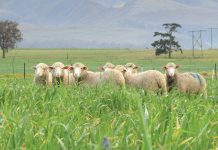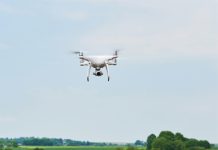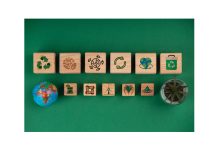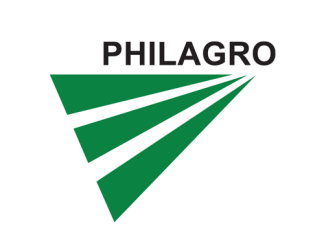
Dr Jaap Knot,
ASSET Research

Dr Hendrik Smith, ASSET Research

Liane Erasmus, ASSET Research

Prof James Blignaut, ASSET Research
With the declining fertility and productive capacity of many South African cropping soils, there is an increasing need to develop more sustainable and profitable cropping systems in these regions. Global and local research studies have shown that cover crops have the potential to address and reverse some of these problems if well managed.
During the past decade several articles in SA Graan/Grain have highlighted the important uses and benefits of cover crops as an integral part of crop-livestock conservation agriculture (CA) systems. These benefits include:
- Livestock integration: Cover crops allow the profitable and sustainable integration of animals in cropping systems. Cover crops are included in or between cash crops and grazed with animals.
- Protecting profits: Cover crops help prevent soil erosion, reduce water runoff, and improve soil structure. This means less damage to crops during heavy rains and better moisture retention during droughts, ultimately safeguarding the producer’s income.
- Healthier soil = bigger yields: These cover crops add organic matter to the soil, feeding beneficial soil microbes and enhancing nutrient availability. Healthier soil means higher yields and better-quality crops, translating to increased profits.
- Reduced input costs (reducing external risk): By reducing the need for synthetic fertilisers and pesticides, summer cover crops can slash input costs. Not only does the producer save money, but he also contributes to a cleaner, more sustainable farming future.
- Biocontrol at work: Most cover crops attract beneficial insects, like lady beetles, which can naturally control pests such as aphids, reducing the need for costly chemical solutions and pesticides.
- Resilient and eco-friendly farming (reducing internal risk): As producers strive to be more environmentally conscious, summer cover crops are a powerful tool. They sequester carbon, mitigate climate change, and promote biodiversity.
On-farm research
Data from four scientific on-farm trials in two summer grain crop production areas in South Africa have been used in this article, namely from the Mpumalanga Highveld area (three trial sites) and the Maluti area in the eastern Free State (one trial site). All the on-farm trials were implemented through the CA Farmer Innovation Programme (FIP) with funding from the Maize Trust and coordination by ASSET Research.
The on-farm trials were conducted for three seasons (from the 2020/2021 production season) during which the three dominant farming systems, namely conventional tillage (CT), no-tillage (NT), and CA were compared. The CA system included several cover crop systems described below.
Cover crop systems in rotation with cash crops
The following section provides information about different multi-species cover crop systems grown during, in between or after cash crops established as part of the CA crop rotations or trial treatments. There are four cover crop systems and strategies included in the CA treatment design, namely:
- Summer cover crops (SCC)
- Winter cover crops (WCC)
- Intercropping into maize
- Winter cover crops after soybeans
The ideal is to utilise all these cover crops by animals through high-density grazing. The aim is to have a diversity of living roots in the soil for the entire year to boost soil health. With mixtures, the aim is to always include species of the three different plant groups: 1) Legume species are most commonly used for adding nitrogen because of their ability to fixate nitrogen to be used by a following crop. 2) Grass species are more widely used to control soil erosion, control weeds, improve nutrient recycling and carbon sequestration and to improve soil structure as a result of soil compaction. 3) Brassicas are used to reduce compaction and increase soil structure through increased levels of organic matter, for bio-fumigation, to recycle nutrients and to suppress diseases and weeds.
A more detailed description of the cover crop systems is as follows:
Summer cover crops
(During the growing season, in between cash crops. When planted with winter cover crops in the same season, it serves as a double cover crop system.)
SCC are mixed, such as babala, forage sorghum, cowpeas, soybeans, dolichos lablab and sunn hemp. These multi-species systems should preferably be grazed twice or more in the growing season, once in early summer to stimulate root growth (with five times more root growth after the first grazing) and once in late summer to increase organic matter decomposition. If required, crops could be terminated with herbicides or with a knife roller; time of termination depends on the need to store or conserve soil water for the next crop. See Photo 1 for an example of a SCC mixture. In the trials used in this study, WCC are planted after SCC are grazed, slashed or terminated (in February) as a so-called double cover crop system.
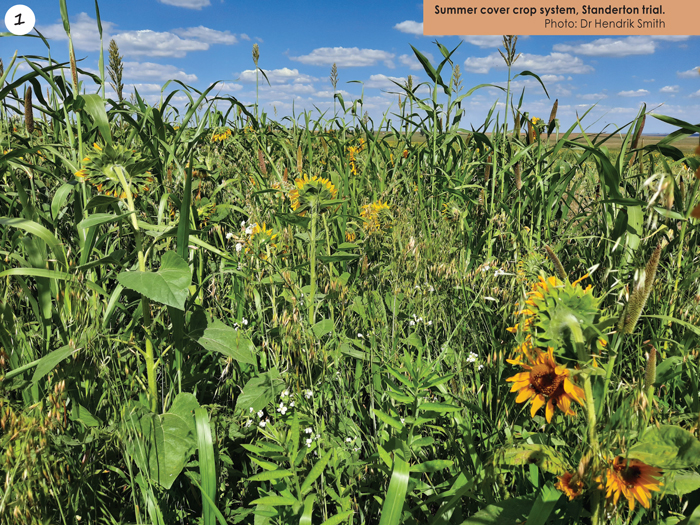 Intercropping
Intercropping
(During growing season, simultaneously with maize)
Depending on the type of cropping system, non-climbers (such as cowpea) or climbers (dolichos lablab) can be sown two to eight weeks after planting maize. Later plantings have less impact on maize yield, however, the earlier the cover crops are sown, the greater the soil protection and weed suppression obtained. See Photo 2 for maize intercropped with SCC. Relay cropping is the technique of seeding mostly WCC into a maize crop later in the growing season, for example around February. The cover crops germinate and grow slowly under the maize canopy.
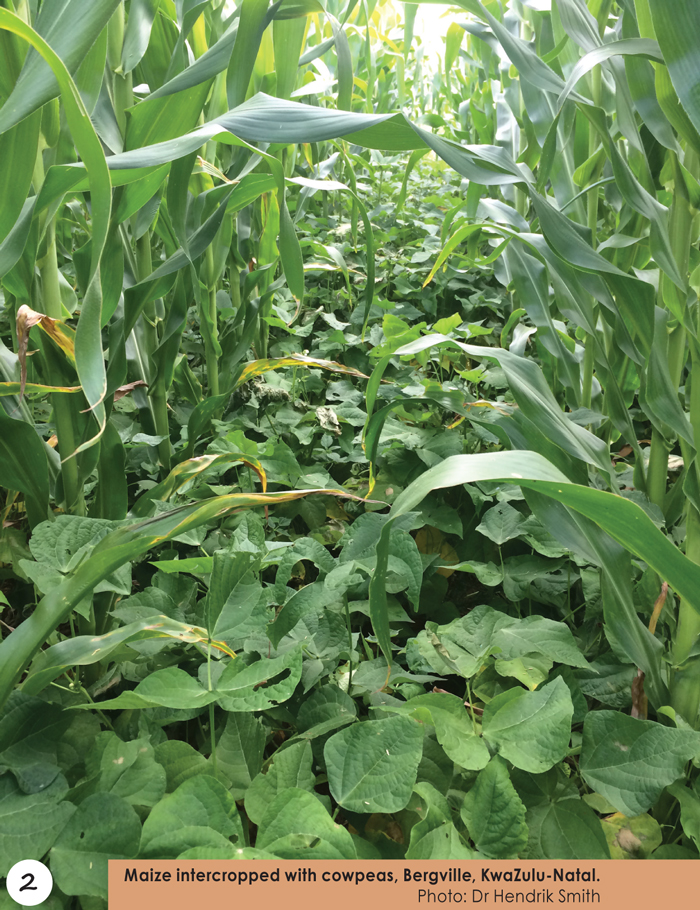 When the maize is harvested in the winter, the cover crops are already established and growth resumes, saving valuable time. Generally, the relay crop will have far more growth throughout the winter and spring, than will any cover crop seeded sooner after planting maize, as it was done at two of the four trials. Apart from the advantage for livestock integration, there are many other economic and environmental benefits. See Photo 3 for maize relay intercropping with a WCC mixture.
When the maize is harvested in the winter, the cover crops are already established and growth resumes, saving valuable time. Generally, the relay crop will have far more growth throughout the winter and spring, than will any cover crop seeded sooner after planting maize, as it was done at two of the four trials. Apart from the advantage for livestock integration, there are many other economic and environmental benefits. See Photo 3 for maize relay intercropping with a WCC mixture.
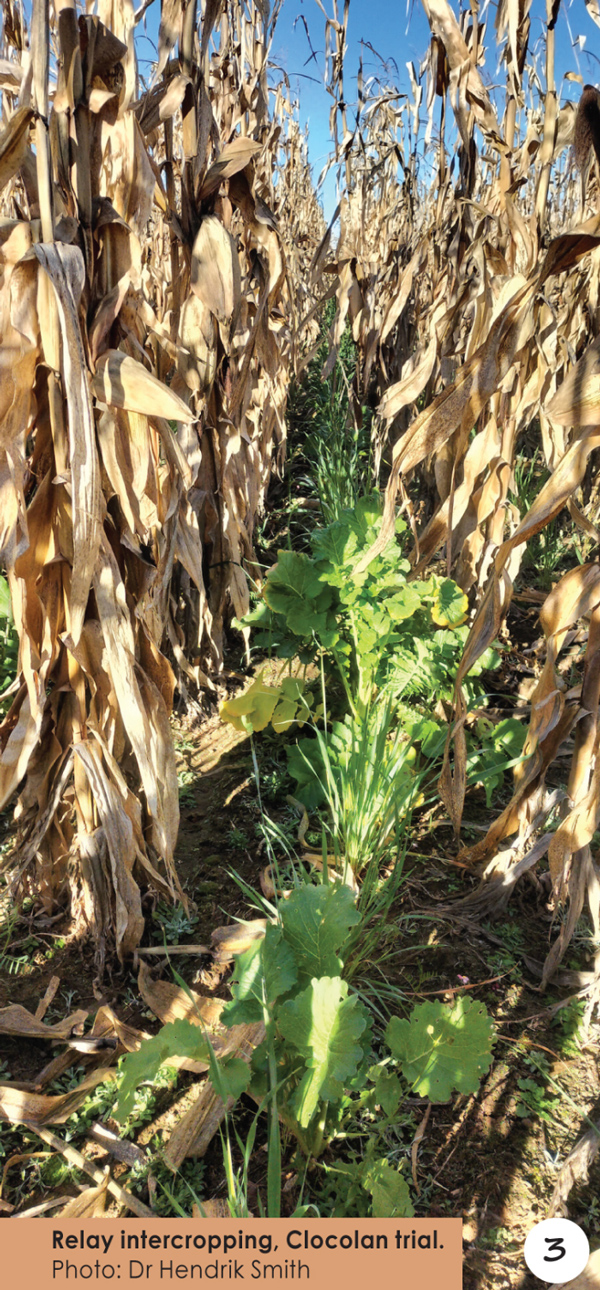 Winter cover crops
Winter cover crops
(After soybeans)
WCC grasses, such as cereal rye, wheat, oats, or triticale, can be planted to accumulate soil organic matter, recycle nutrients, and reduce soil compaction. Brassicas (oilseed or tillage radish or turnips) recycle nutrients, reduce compaction, and promote weed and disease suppression (bio-fumigation). Legumes, such as vetch, can be planted as a nitrogen source. See Photo 4 for a winter mixture.
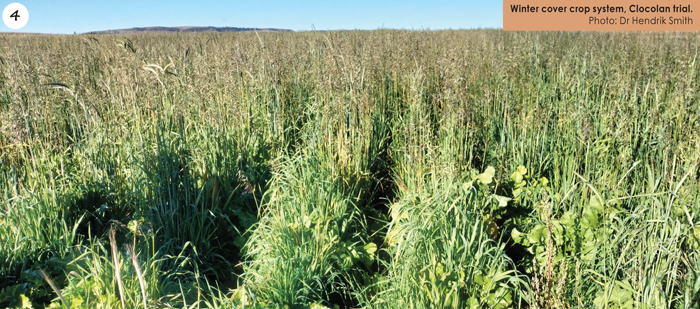 Crop rotations
Crop rotations
The production systems or crop rotations (CR) used in the four trial treatments over three seasons are indicated below.
- Maize CT; soybean CT; maize CT
- Maize NT; soybean NT; maize NT
- Maize + relay intercropping; SCC + WCC; soybean + WCC
- SCC + WCC; soybean + WCC; SCC + WCC
- SCC + WCC; maize + relay intercropping; SCC + WCC
- Soybean CT; maize CT; soybean CT
- Soybean NT; maize NT; soybean NT
- Soybean + WCC; SCC + WCC; maize + relay intercropping
- Maize CT; maize CT; maize CT
Analysis of risk and resilience
To analyse the above crop production systems or treatments, a risk and resilience barometer was designed using data from parameters measured at the different treatments. This has been done in the following manner:
-
- An internal risk index was calculated based on soil organic matter, water use efficiency and soil cover. The index has been designed in such a way that the higher the index value, the higher the system resilience. Thus the higher the difference between the season 3 and season 1 composite value is, the more resilient the system is becoming. The individual components of the metric have been compiled as follows:
-
- The soil organic matter for each plot was expressed as a percentage of the soil organic matter of the control site, which is natural veld. The higher the percentage, the better. Soil organic matter accounts for 20% of the weight of the internal risk index.
- The water use efficiency, counting for 30% in the metric, has been calculated by compiling a water use efficiency target using the potential yield by cash and cover crop for the rainfall received based on the yield gap concept, and applying efficiency factors of 40%, 50%, 60% and 70% to years 1 to 4 to allow for learning. The actual water use efficiency is expressed relative to the target. The higher the percentage, the better.
- The soil cover for each plot was expressed as a percentage of the soil cover of the control site, which is natural veld. The higher the percentage, the better. Soil cover accounts for 50% of the weight of the internal risk index.
- An external risk index was calculated based on the cost of inputs on a per hectare basis. An index based on the sum of the actual input cost data over the three seasons was computed. The minimum of each trial was used as enumerator relative to the input cost of the rotation. The higher the index, the lower the relative input cost and thus the more resilient the system.
- A profitability index was calculated based on the net margin on a per hectare basis. An index based on the sum of the actual net margin data over the three seasons was computed. The total was expressed relative to the maximum of each trial. The higher the index, the higher the net margin and thus the more resilient the system.
Results of risk and resilience analysis
A composite risk and resilience index that was calculated with the internal and external risks weighing 25% each with profitability weighing 50%, is provided in Figure 1 representing the average for all the crop rotations and trials over three years.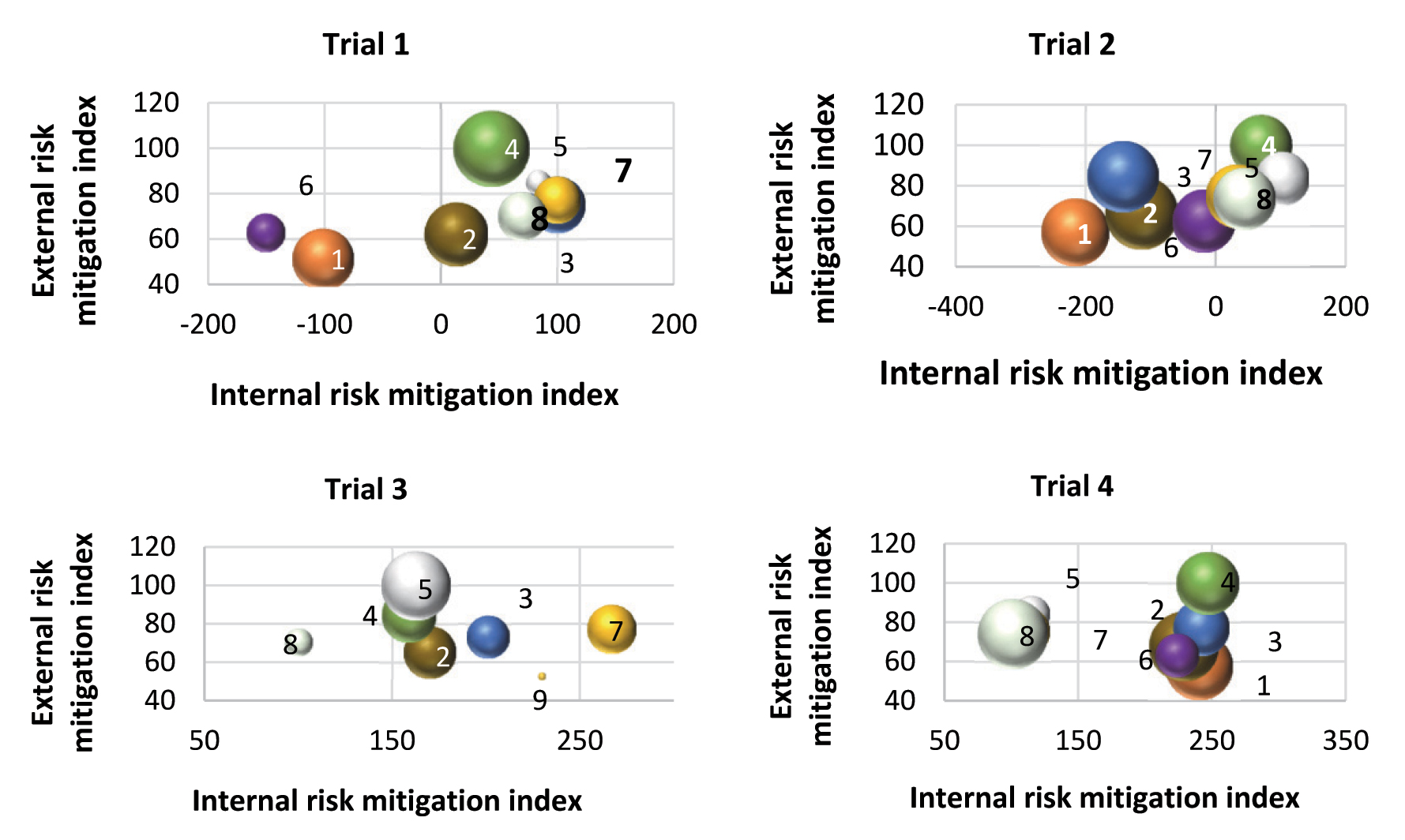
Figure 1: Graphic overview of risk assessment of different crop rotations.
Notes: The higher the score and the bigger the bubble (profitability), the higher the system resilience.The risk analysis results for the four trials are indicated in Graph 1, where the numbers are referring to the treatments from 1 to 9 described above.
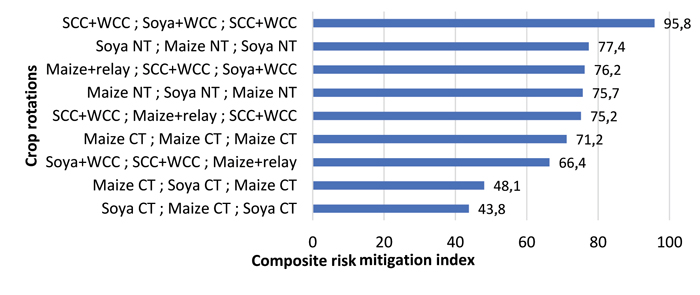
Graph 1: Average of internal and external risk scores and profitability of the different treatments in four trials over the 2021, 2022 and 2023 seasons. (The higher the score, the higher the risk mitigation and the better the resilience of the system). Discussion of results
After three years of data (from 2020 to 2023) the composite index in Graph 1 and Figure 1 for crop rotation (CR) treatments in all four trials shows that the most risk averse and resilient systems were:- CR4 (CA: SCC + WCC; soybean + WCC; SCC + WCC)
- CR7 (NT: soybean; maize; soybean)
- CR3 (CA: maize + relay; SCC + WCC; soybean + WCC)
- CR2 (NT: maize; soybean; maize)
- CR5 (CA: SCC + WCC; maize + relay; SCC + WCC)
The results show that CA crop production systems and NT rotations are the least risky and most resilient. The riskiest system is CT (Graph 2). The least risky and most resilient crop rotation over three seasons is CR4: (CA: SCC + WCC; soybean + WCC; SCC + WCC) (see Graph 1 and Figure 1). Each of the seasons in the three-year CR4 included cover crop systems described above. Furthermore, three of the top five crop rotations include CA with cover crop systems. It clearly highlights the role of cover crops to reduce risk and improve resilience.
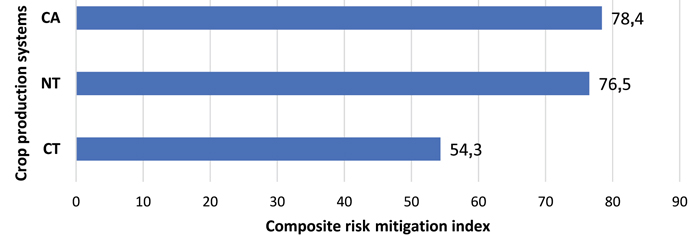
Graph 2: Average of internal and external risk scores and profitability of the different crop production systems in four trials over the 2021, 2022 and 2023 seasons. (The higher the score, the higher the risk mitigation and the better the resilience of the system). Preliminary conclusions
The results to date show that integrated CA with cover crops and livestock integration have a positive short-term effect on risk and resilience, even in a period with above average rainfall.However, continuous data collection and analyses will aim to test the following project hypotheses over the longer term – that the positive effects of CA with cover crops and livestock integration on risk and resilience will do the following:
- Be more noticeable during seasons with negative climate and crop margin conditions, stabilising yields and income.
- Increase over time as its management and efficiency improve to reach its full potential.
- Increase over time as the ecosystem functions and services are restored, such as soil organic matter, soil cover and water use efficiency.
These conclusions imply that CA performance in the trials hasn’t reached its full potential or limit yet and can still improve its risk and resilience performance substantially. NT and especially CT, however, have reached their limit, or have only limited options left to improve. For example, it is difficult to cut input costs of NT/CT systems without significantly losing yields, and with little to no anticipated or possible cuts in future input costs, the cost squeeze increases annually.
This risk assessment will assist in identifying the most resilient and profitable systems in the Highveld grain production areas of South Africa. Three years of data analyses showed that cover crops and CA soybean strongly feature in the lowest risk scenarios discussed, including WCC after SCC (as a double cover cropping system), WCC after soybean, or cover crops intercropped with maize.
Apart from intensive data collection and analyses seen in this article, these research projects also aim to find real solutions for practical problems producers face implementing these cover crop systems. These include intercropping into maize with narrow rows, or doing relay intercropping when the cash crop is already matured, grazing practices, and weed management. Strategies and technologies are being explored to overcome these challenges.
-
- An internal risk index was calculated based on soil organic matter, water use efficiency and soil cover. The index has been designed in such a way that the higher the index value, the higher the system resilience. Thus the higher the difference between the season 3 and season 1 composite value is, the more resilient the system is becoming. The individual components of the metric have been compiled as follows:




